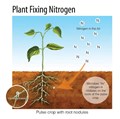
Nitrogen is one of the most essential nutrients for plant growth. It plays a vital role in building proteins, nucleic acids, and chlorophyll. Despite its abundance in the atmosphere, nitrogen in its gaseous form (N₂) isn’t directly usable by most plants. Instead, it needs to be converted into accessible forms like ammonia (NH₃) or nitrate (NO₃⁻) through a process known as nitrogen fixation.
For farmers and agricultural researchers, enhancing this natural process holds significant promise. It means healthier soils, increased crop productivity, and reduced dependence on synthetic fertilizers—which are not only costly but can also cause environmental harm when overused.
Understanding Nitrogen Fixation
Nitrogen fixation refers to the conversion of atmospheric nitrogen into a form that plants can use. This transformation is carried out by certain microbes and, to a lesser extent, through industrial or natural chemical processes.
Biological nitrogen fixation is perhaps the most important method in agriculture. It occurs thanks to the work of specific bacteria and cyanobacteria. Some of these microbes live independently in the soil, while others form intimate partnerships with plants—especially legumes—by residing in nodules on their roots. This symbiotic relationship benefits both parties: plants get a steady supply of usable nitrogen, and bacteria receive sugars and a stable environment.
There are also industrial methods, such as the Haber-Bosch process, which synthesizes ammonia from nitrogen and hydrogen for use in chemical fertilizers. Nature contributes too, in a small way, through lightning, which can transform atmospheric nitrogen into reactive compounds that are deposited into soil through rain.
Why Enhancing Nitrogen Fixation Matters
Encouraging natural nitrogen fixation isn’t just a cost-saving measure. It represents a shift toward more sustainable and regenerative agricultural practices. When soils are naturally enriched with nitrogen, crops grow more vigorously, and farmers become less reliant on synthetic inputs.
More than that, enhancing nitrogen fixation contributes to environmental sustainability. It minimizes the runoff of excess fertilizer into waterways, which can lead to problems like algal blooms and dead zones. It also promotes biodiversity in the soil, creating a more resilient ecosystem that can better withstand droughts, pests, and disease.
Strategies for Improving Nitrogen Fixation
One of the most direct ways to enhance nitrogen fixation is by working with the soil’s microbial life. This involves promoting both symbiotic and free-living nitrogen-fixing bacteria. For legumes, inoculating seeds with efficient strains of Rhizobium or Bradyrhizobium can improve nodule formation and nitrogen assimilation. Maintaining optimal soil conditions—particularly a balanced pH and adequate moisture—also encourages these beneficial relationships.
Even plants that don’t form nodules can benefit from non-symbiotic nitrogen-fixing bacteria like Azotobacter and Clostridium, which live freely in the soil. These microbes can be supported by incorporating cover crops such as clover and alfalfa, which contribute to nitrogen buildup in the soil as they decompose.
Healthy soils are critical to the entire process. Soils rich in organic matter tend to host more diverse and active microbial communities. Practices like composting, mulching, and reduced tillage help preserve these communities and foster the conditions they need to thrive. Adding biofertilizers and natural amendments further strengthens microbial populations, ensuring they remain active and effective.
Supporting Soil Life and Microbial Health
Encouraging nitrogen-fixing microbes starts with understanding what they need. Soil pH should generally stay around 6.0 to 7.5 to support microbial activity. Overly compacted or waterlogged soils can limit aeration and suffocate bacteria, while excessive use of chemical nitrogen fertilizers can actually suppress natural fixation processes by making plants less reliant on microbial help.
Crop rotation and intercropping are other powerful tools. Growing legumes alongside cereals or alternating them in different seasons allows farmers to balance soil nutrients and encourage the proliferation of helpful bacteria. In the long term, this reduces the need for synthetic inputs and leads to more fertile, self-sustaining soils.
Applying Biofertilizers and Natural Growth Promoters
Biofertilizers offer an effective way to introduce or enhance populations of nitrogen-fixing microbes in the soil. Products containing Rhizobium, Azospirillum, or Azotobacter can be applied to seeds or soil to establish these beneficial relationships early in the growing season. Mycorrhizal fungi and plant growth-promoting rhizobacteria (PGPR) are also commonly used to support root health and nutrient uptake, indirectly aiding nitrogen fixation.
These biologically-based products are especially useful in soils that have been depleted by long-term chemical use or monocropping. By reintroducing microbial life and improving soil structure, they help rebuild fertility from the ground up.
Environmental Factors and Sustainable Practices
Nitrogen fixation is sensitive to environmental conditions. Temperature, moisture, and even seasonal changes can affect how efficiently bacteria perform their roles. In general, moderate temperatures and adequate—but not excessive—moisture levels are ideal. Too much disturbance from heavy tilling or machinery can disrupt delicate microbial habitats, so conservation-focused farming methods are often more favorable.
Sustainable approaches like agroforestry, precision farming, and organic amendments play a growing role in promoting long-term nitrogen fixation. Integrating nitrogen-fixing trees such as Acacia or Leucaena into crop systems not only enriches the soil but also provides shade, wind protection, and additional biomass. Using data-driven techniques to monitor soil conditions helps farmers apply inputs more strategically, ensuring nutrients are available when and where they’re needed.
Enhancing nitrogen fixation in plants isn’t a single solution—it’s a system of interrelated practices rooted in biology, ecology, and good land stewardship. By working with microbes, maintaining healthy soil, choosing smart crop combinations, and respecting environmental limits, farmers can foster naturally nitrogen-rich ecosystems. This not only reduces the reliance on synthetic fertilizers but also lays the foundation for a more resilient and sustainable form of agriculture.
At its core, amplifying nitrogen fixation means tapping into the wisdom of nature—harnessing the power of microbes and soil life to build fertility from within. It’s a future-forward strategy that benefits both plants and the planet.
















